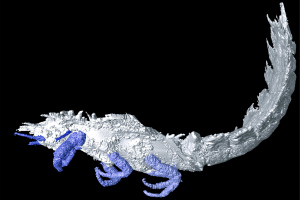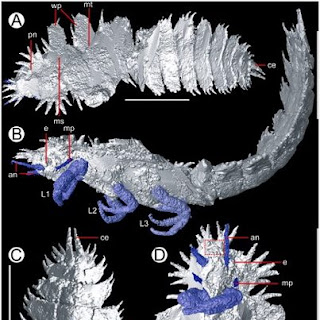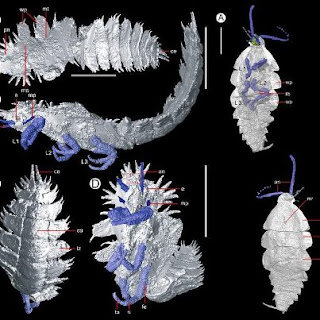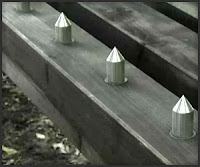3D Images of 300 Million Years Old Insects
Researchers at University of Manchester recently dropped a bombshell when they unveiled 300-million-year-old insects captured in 3-D images.
Speaking to PLOS ONE journal, they attribute their success to high resolution CT scanning technique, through which 2 juvenile insects believed to be 305-million-year-old were reconstructed. Without the help of such cutting edge imaging technology, these 2 insects would remain as holes in the rock, let along the stunningly vivid images put to the world. It is not a photo job by anybody. A CT scan is performed on the fossils, and along the way produces 2,000 slices of images from various cross sectional views.
Image [Click to enlarge]
Reconstruction efforts are based on these slices, and the fossils are transformed into vivid 3D digital models. The discovery is significant in that it helps us to understand more about these prehistoric creatures, from lifestyle to insect diets, and their biological makeup and the adaptation necessary for survival.
One observation that stood out is imagines of numerous sharp spines on the insects. Suffice to say that such species are no longer in existence today.
The other interesting observation is the discovery of one early predecessor of cockroach, unanimously believed to be the longest surviving insect. Its previous form is fairly elusive so the new images would please even the most authoritative insect palaeontologists. The reconstruction shows fairly well developed mouthparts, possibly due to a rotting litter diet from the forest floor.
Image [Click to enlarge]
Both specimens could be traced to pre-historic specie called Polyneoptera -- which counts mantises, roaches, grasshoppers, crickets and earwigs among its family. But according to the University of Manchester's School of Materials' professor, Dr Russell Garwood, it may be a tough call to determine the exact relationships of the insects. And the reason is that insects habitually change their shape and form as dictated by evolution.
Dr Garwood said: "The most dramatic change is seen in insects like butterflies, which change from a larva, to chrysalis, to adult. But relatively few people look to the fossils try and work out how such a life cycle may have evolved."
Nevertheless the new images have made possible more detailed study on the biology as well as the development of the early insects, and the transitions that led to their current forms.
Image [Click to enlarge]
Some of the strange sightings from these images perhaps could be explained by the presence of early 'amphibians' during that pre-historic age. They belong to a class called insectivores – for their likings of insects in their diets. It will take more convincing to explain that creature with spine, as there has been no precedence on any Polyneoptera alive today. It is no doubt bizarre but that does not take away anything from this spectacular work.
But there is a ready explanation on the roach nymph. It is similar to cockroaches of moder times in appearance – and the departure from common characteristics of a 'true' cockroach can be explained by its predated existence, most likely a hybrid between cockroaches and mantises.
Image [Click to enlarge]
Professor Philip Withers, one of the researchers involved in the project, is elated with the reception from fellow scientists on the reconstruction work. He conceded that while the 3D imagery makes stunning display, what is more significant is that it open doors to provide a more detailed and holistic study on our predated world. He is committed to bring more fossils into 3D prints in the coming years.







Comments
Post a Comment